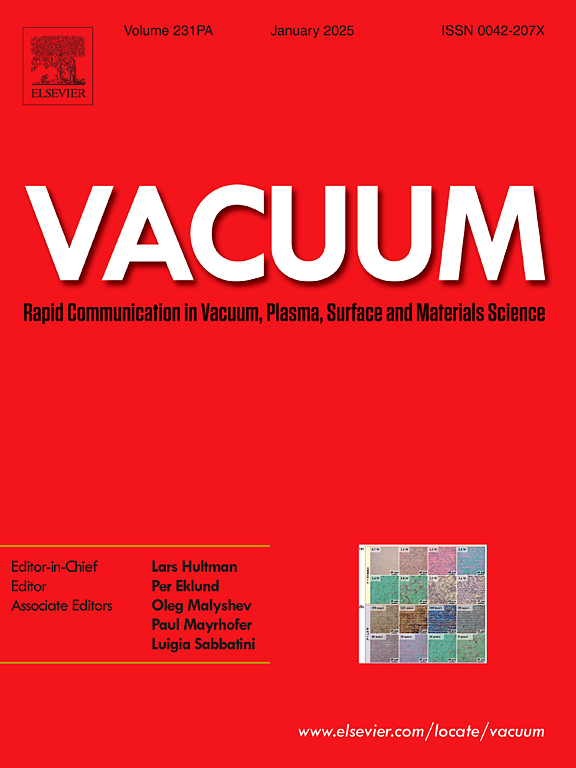Study on the influence of slot structure on the arcing characteristics of vacuum arc between transverse magnetic contacts
IF 3.8
2区 材料科学
Q2 MATERIALS SCIENCE, MULTIDISCIPLINARY
引用次数: 0
Abstract
As a key switching device in power systems, vacuum circuit breakers face reduced interrupting capability due to arc erosion on contact surfaces. The dynamic behaviour of vacuum arc during arcing processes and the impact of contact surface erosion are examined by comparing two transverse magnetic field (TMF) contact structures: spiral-type TMF contact and cup-shaped TMF contact. Through numerical simulation, the regulation mechanism of slot structures on arc motion and erosion distribution is revealed. Experimental results demonstrate that spiral-type TMF contacts reduce arc constriction through arc slot crossing, yet suffer aggravated local erosion at slot edges due to arc stagnation. Cup-shaped TMF contacts exhibit higher arc constriction with more centralized erosion distribution. Thermal process simulations further indicate that slot structures disperse arc energy across slot regions, delaying the formation of high-temperature zones on opposite contact surfaces and causing arc stagnation. The introduction of preheating conditions enables earlier formation of continuous high-temperature zones on anode surfaces. The stagnation time decreased to 1.0 ms with a simultaneous rise in motion speed to 173.4 m/s, ultimately alleviating slot edge erosion. The correlation mechanism between contact structures and arc characteristics is elucidated, thereby establishing a theoretical foundation for optimizing vacuum circuit breaker contact designs.
狭缝结构对横向磁触点间真空电弧电弧特性影响的研究
真空断路器作为电力系统中的关键开关设备,由于接触面电弧的侵蚀,使其开断能力下降。通过比较两种横向磁场(TMF)接触结构:螺旋型和杯形TMF接触结构,研究了真空电弧在电弧过程中的动态行为和接触面侵蚀的影响。通过数值模拟,揭示了槽结构对电弧运动和冲蚀分布的调节机理。实验结果表明,螺旋型TMF触点通过穿越电弧槽减小电弧收缩,但由于电弧停滞,使电弧槽边缘的局部侵蚀加剧。杯形TMF触点弧缩度高,冲蚀分布更集中。热过程模拟进一步表明,槽结构将电弧能量分散到槽区域,延缓了相对接触面上高温区的形成,导致电弧停滞。预热条件的引入使阳极表面上的连续高温区更早形成。停滞时间减少到1.0 ms,同时运动速度增加到173.4 m/s,最终缓解了槽边侵蚀。阐明了触点结构与电弧特性的相关机理,为真空断路器触点优化设计奠定了理论基础。
本文章由计算机程序翻译,如有差异,请以英文原文为准。
求助全文
约1分钟内获得全文
求助全文
来源期刊

Vacuum
工程技术-材料科学:综合
CiteScore
6.80
自引率
17.50%
发文量
0
审稿时长
34 days
期刊介绍:
Vacuum is an international rapid publications journal with a focus on short communication. All papers are peer-reviewed, with the review process for short communication geared towards very fast turnaround times. The journal also published full research papers, thematic issues and selected papers from leading conferences.
A report in Vacuum should represent a major advance in an area that involves a controlled environment at pressures of one atmosphere or below.
The scope of the journal includes:
1. Vacuum; original developments in vacuum pumping and instrumentation, vacuum measurement, vacuum gas dynamics, gas-surface interactions, surface treatment for UHV applications and low outgassing, vacuum melting, sintering, and vacuum metrology. Technology and solutions for large-scale facilities (e.g., particle accelerators and fusion devices). New instrumentation ( e.g., detectors and electron microscopes).
2. Plasma science; advances in PVD, CVD, plasma-assisted CVD, ion sources, deposition processes and analysis.
3. Surface science; surface engineering, surface chemistry, surface analysis, crystal growth, ion-surface interactions and etching, nanometer-scale processing, surface modification.
4. Materials science; novel functional or structural materials. Metals, ceramics, and polymers. Experiments, simulations, and modelling for understanding structure-property relationships. Thin films and coatings. Nanostructures and ion implantation.
 求助内容:
求助内容: 应助结果提醒方式:
应助结果提醒方式:


